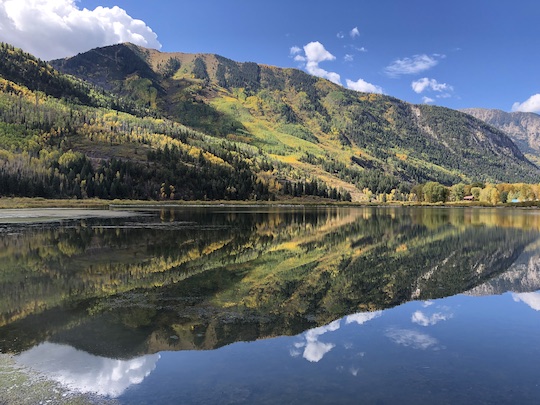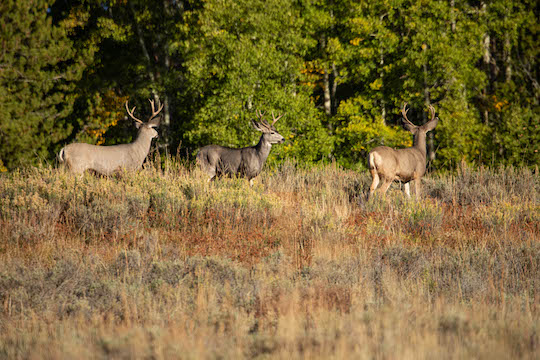After a moving day, we were ready to get out and move again. Our best rewards on these trips involve medium to long hikes, not to mention that we had a toddler along that wants nothing more than to keep moving. Long days in the car wear on all of us accordingly. After a night spent listening to the camp deer munching shrubbery just outside the tent, we were up and ready for adventure.
Because of the issues with water, we developed a new routine for our two nights at State Forest State Park. Mornings were chilly enough, that it was nice to get up and head straight for the vehicle. Cranking the heat a little got us all warmed up and ready for the day. Our goal was to do a short drive while it was cold, then stop for breakfast at a different campground that had water. Thankfully, it had very few people in it, so we could just pick a table and set up for breakfast. Nobody ever bothered us either, and while I know most places are funny about you picnicking in campgrounds, I was annoyed enough that I didn't care.
Moose in State Forest State Park
Our goal that morning was to find some moose. That is always high on my agenda on trips to Colorado. On this trip, it didn't take long. We were still creeping along the rough gravel road away from camp when we spotted a cow and half grown calf. Lighting wasn't great, so after a few half hearted attempts at pictures, we kept going. That proved to be the right decision. Shortly after getting on the main road and heading further down the mountain, we found a magnificent bull moose foraging in the early morning glow.
Fall Colors, Scenery, and Wildlife at State Forest State Park
After spending a decent amount of time with him via our cameras, we headed on down the hill to drive into a part of State Forest State Park that I've always enjoyed for fall colors. The early morning sun was slanting over the mountains now, illuminating trees that were exploding in gold. While much of the foliage was still a week or two out from peak colors, there were enough trees turning to make the trip worthwhile.
Winding further into the Park on dirt roads, we soon approached North Michigan Creek Reservoir. I have fished the North Michigan upstream from this small lake, but have always been intrigued by the lake itself. Fish rising everywhere didn't help that, but we were on a mission. So, after a couple of pictures of the lake, we headed on.
We hadn't even finished passing the lake yet when we noticed something else of interest. Three quality bucks were running along a ridge above us. Something off over the ridge had them concerned, but they stopped long enough for us to take a couple of pictures. Not the moose we were looking for, but still a treat!
The deer were one of our last big game sightings of the day. We would see another moose not long after, but he was running full speed across the road in some fairly heavy brush, so we only got a quick glimpse before he had vanished. Still, the fall colors did not disappoint. A few more pictures, and then it was time to switch gears and go fix breakfast.
The Road to Lake Agnes
After breakfast, it was time for our real adventure of the day. I had done some research and wanted to hike to at least one lake and possibly two. By the time we finished, however, the one hike would end up being plenty. We debated trying to do the hike all the way from camp, but a much closer starting point appealed since it would greatly shorten the hike and leave us the option of more hikes, or so we thought.
Driving up the dirt road towards Lake Agnes, things were supposed to be rough. They have all the usual signs about recommending 4 wheel drive and high clearance. I learned a long time ago that those signs are often not really accurate, and figured this time would be the same. We poked slowly up the hill in my wife's little Corolla, dodging a few larger tire popper rocks but generally making good headway.
The problem came when we approached a sharp curve that switch backed up the hill. There were lots of ruts and plenty of deep soft dirt. In other words, we were in trouble. I got out to look things over, knowing that I still had the option of turning around before I got us stuck. Upon closer inspection, I could see a vague line that just might work. I've done these crazy (stupid?!?!) things a few times over the years and found that generally you could make it through in a sedan.
I'll pause to say right now that we should have videoed this whole thing. The line that might work without completely burying the car was low on the downhill outside edge of the curve. I got a good start but quickly bogged down since we were trying to make the turn. Then things went from bad to worse. Every time I backed up a little and tried again, we slid downhill a little more.
Before things were over, the back end of the car was in a good sized evergreen tree on the side of the road with the toddler screaming her delight. She thought it was the most hilarious event of the whole trip. My wife wasn't as amused. The poor car put up a valiant fight, but seemed to be in danger of losing this round. Since I didn't have any shovels or other tools, it was going to be a pain in the rear to dig it out and retreat down the hill. Finally, after a silent prayer and another try, we were somehow on our way, skidding and spinning our tires up and around the curve. It was a true miracle, but I'll definitely take it.
After the bad curve, things were anticlimactic. As I expected, the road was fine as long as you paid attention. If it wasn't for that one curve, this road would definitely be fine for 2 wheel drive sedans if the drivers know how to negotiate rougher roads. In the back of my mind, I had the nagging thought that we still needed to get back down the hill, but for the time being, I was just glad to be hiking up to Lake Agnes.
Hiking and Tenkara Fishing at Lake Agnes
This hike is a short one at under a mile from the parking lot to the lake. Once you add in the loop around the lake, it is still probably under 2.5 miles. We assumed that since it was such a short hike and we had just had breakfast, that we wouldn't need to take a lunch. That was a mistake! We enjoyed our time so much that we could easily have spent the rest of the day up there. In the end, we felt rushed because it was important to get back to our vehicle for lunch for the little one (and ourselves!).
Lake Agnes itself is absolutely gorgeous. The towering Nokhu Crags along with Mt. Mahler and Mt. Richthoven surround this beautiful basin. We kept stopping and taking pictures, although as always seems to be the case, pictures simply do not do this place justice. The time of day wasn't great for pictures either with bright sunlight. Still, we had to have some memories.
Wildlife abounds. One of our favorites is the pika, and we constantly heard their calls on the surrounding slopes. My wife snuck off to try and capture some pictures of them while I poked around with the tenkara rod. Little bit was riding on my back, mostly happily, although we also let her down in a couple of spots to burn some energy. Here are a couple of the better pika pictures.
While Leah was photographing wildlife, I was plying the waters of Lake Agnes using my Tenkara USA Rhodo and what was quickly becoming my preferred high country lake rig: a parachute Adams on top and a pheasant tail nymph on the bottom. Fish were cruising, often just out of casting range. This is the downside of fishing Tenkara on bigger water. Still, I eventually found some in close enough to shore on the south end of the lake.
We continued our circuit of the lake, but time was running out. We were all getting hungry, but this was especially true of the toddler. It was time to head back down the hill to our car and try to negotiate that horrendous curve back down to camp. After one or two last pictures, we quickly descended to the trailhead. The drive back down was anticlimactic. My concerns were groundless. With gravity behind us instead of against us, the curve was a piece of cake and we were soon back at camp having lunch.
Afternoon Drive Through State Forest State Park
Our morning adventures concluded rather late, so after lunch, we needed to find a way to get a nap in for the little one. The hike had been too interesting for her to get a good nap in, so we decided on the old trick of going for a drive. It always works for her although sometimes better than other times. On this day, she was tired and knocked out quickly. We drove back to some of the same scenes from the morning. The fall colors were beautiful although not as nice as they would be another week or two after our visit.
The day got away from us rather quickly. After our drive, we got water from Ranger Lakes Campground, had supper, and headed back to camp for our last night in this beautiful place. While the water situation was frustrating, we'll definitely be back to this area. I wouldn't mind doing some overnight backpacking into some other high country lakes someday as well. The sunset that evening gave us one last gift before out time at State Forest State Park ran out.

















































